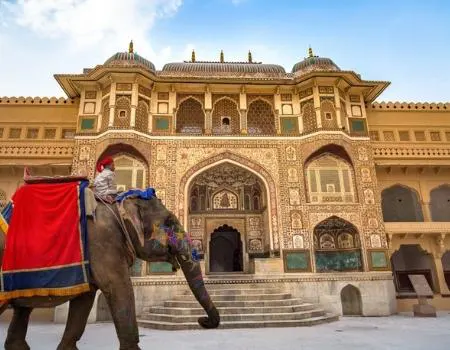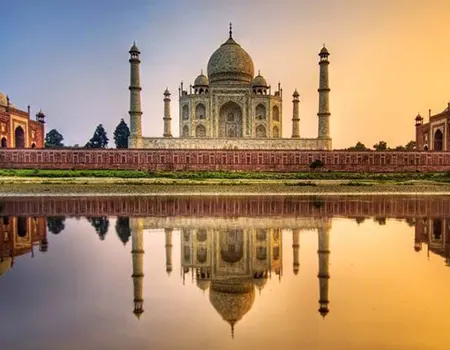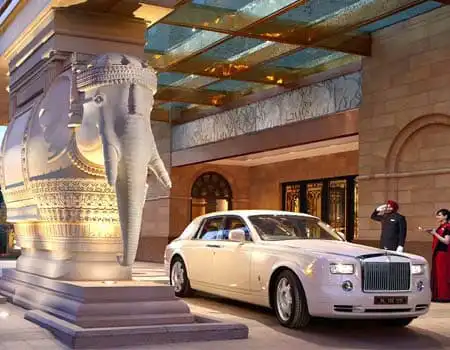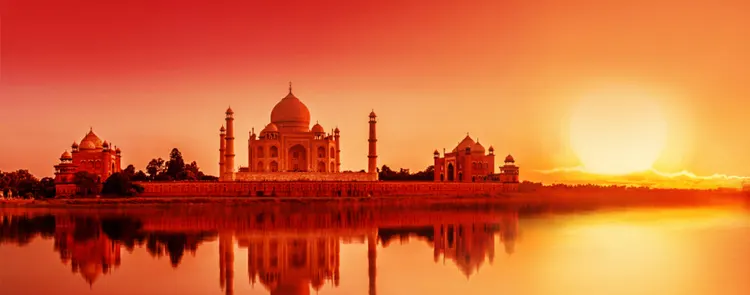
Nestled on the south bank of River Yamuna, the Taj Mahal is an immense mausoleum of the white marble that sets a true example of Love. The Great Wonder was built between 1631 to 1648 by the Mughal Emperor Shah Jahan in memory of her beloved wife Mumtaz. It sets in Agra, the Mughal Capital is a jewel of Islamic art in India and one of the most famous World Heritage Sites.
Agra, the city located in the heart of India is part of the Golden Triangle Tour Packages. It was once the capital of India from 1833 to 1868. The city was prior founded by Sultan Sikander Lodhi, along with the great Mughal emperor Babar, the founder of the Mughal dynasty who also introduced the concept of Square Persian Styled Gardens. Later the city was adorned with magnificent monuments by the great Akbar such as Agra Fort, Fatehpur Sikri, and more.
With its harmonious proportions and its exotic incorporation of decorative elements, the Taj Mahal is known as the finest example of ancient Mughal Architecture. The site is a true blend of Islamic, Indian, and Persian style and emerged as the world’s most iconic monuments. In 1983, the wonderful complex was designated a UNESCO World Heritage Site. Eager to know the history of the Taj Mahal!! Let’s read more!
| Monument Location | 27°10′30″N 78°02′31″E |
| State | Uttar Pradesh |
| City | Agra |
| Area | 42-acre (17-hectares) |
| Height | 73 meters (240 ft) |
| Built | 1632-1653 |
| Built By | Mughal Emperor Shah Jahan |
| Architect | Ustad Ahmad Lahauri |
| Architectural Style | Mughal Architecture |
| Built For | Mumtaz (Wife of Shah Jahan) |
| Nearest Airport | IGI Airport, Delhi |
| Nearest Railway Station | Agra Fort, Agra Cantt, Raja-ki-Mandi |
| Nearest Bus Station | Central Bus Station Agra |
| Taj Mahal Opening Time | 06:00 am |
| Taj Mahal Closing Time | 06:00 pm |
History of the Taj Mahal

Built by the brave Mughal Emperor Shah Jahan in 1648, in remembrance of her beloved wife Mumtaz and since then, it was also known as Mumtaz Mahal. She was a true emperor’s inseparable companion since their marriage and got apart after her demise in 1631 while giving birth to the great heir to the Mughal Dynasty.
The plans for building the complex have been attributed to various architects of the period, and probably choose an Indian of Persian descent, Ustad Ahmad Lahori who stood as the chief architect of the grand Taj Mahal. The complex featuring the main five elements- main entrance gate, Mosque, Jawab (meaning answer; a building mirroring the mosque), square Persian-styled gardens, and mausoleum which includes its four minarets were designed as a unified entity and which was later listed under one of the Great Wonders in the World.
The construction of the building commenced in 1632, and the entire complex was ready in 1947 including all decoration work. More than 20,000 skilled workers and labourers were called from India, the Ottoman Empire, Europe, and Persia to complete the Mausoleum stretched in an area of about 42 acres or 17 hectares with a building time spanned 22 years.
According to history, it is believed that Shah Jahan intended to build another mausoleum across the Yamuna River to bury his own remains but it did not happen. He spent the rest of his life imprisoned in Agra Fort. In 1658, he was deposed by his son Aurangzeb next to his beloved wife in Taj Mahal’s entrance to state- “O soul, you are at rest. Return to the Lord in peace with him, and he is at peace with you.”
Best Time to Visit Taj Mahal
As such, there’s no definite time to visit the Taj Mahal but the major tourist traffic emerges during the winter season that sets in India from October to March. The weather or climate of the place also contributes to making your memory a lifetime.
During summers, Agra is extremely hot due to its location that lies on the plains which counters the high temperatures. However, during summers, the marble becomes heated up and makes it difficult to walk through or enjoy the scorching hot.
In winter, you can experience the pleasant warmth of the Sun amidst mists that enhance the appealing beauty of the complex. Rains add to the feel of Romance while witnessing the true epitome of love.
No matter, whatever the time of the year, the Taj Mahal is always a glitzy white beauty whose shine is eternal. Catch the enchanting visual beauty of the Taj Mahal especially at sunrise or sunset or under the full moon night.
Timings of Taj Mahal Entry through various gates-
- Western Gate (Main Gate): about 45 minutes before sunset
- Eastern Gate: about 45 minutes before sunset
- Southern Gate: Only Exit permitted
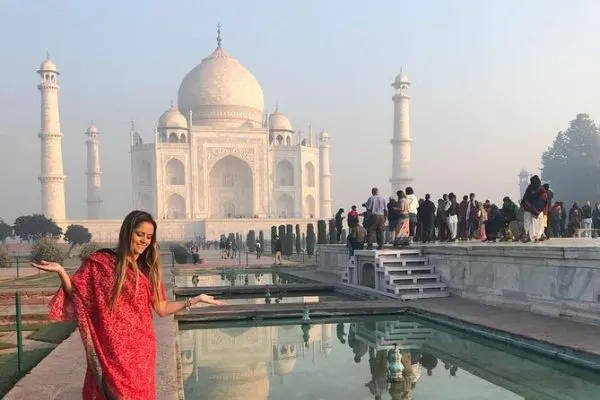
Tickets Price of Taj Mahal
The Taj Mahal entry ticket price for Indians is INR 45. For natives of BIMSTEC or SAARC countries, the ticket price of the Taj Mahal is just INR 535. And if you are a foreign native, the entry price is INR 1050. Children below the age of 15 get free entry (both domestic and foreign tourists).
| Nationality | Entry Fee |
| Indian | INR 45 (Additional INR 200 to sight the main mausoleum) |
| SAARC & BIMSTEC | INR 535 (Additional INR 200 to sight the main mausoleum) |
| Foreigner | INR 1050 (Additional INR 200 to see the main mausoleum) |
| Children Below Age 15 | Free |
Architecture and Design of Taj Mahal
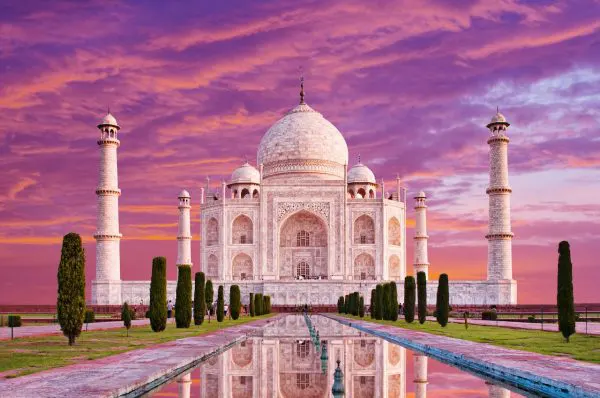
Dissected by the water bodies, the ornamental gardens are typically designed on the lines of the Mughal Charbagh, along with an ornamental marble plinth running through its center. The elevated marble platform stands to the northern end of the Taj Mahal on which the main Mausoleum stands. So nicely built, a 40-meter-high white long minarets embellished each corner of the marble platform, which is known as one of the best engineering masterstroke. Towers of the complex lean outwards and were purposely designed, in case any earthquake hit the place, these minarets fall away untouching superstructure and let it remain unperturbed.
The main entrance of the complex is an ornate Mughal Structure, made of White Marble with tomb-like archways. Every wall and each arch of the Taj Mahal is rich in calligraphy with high vaulted ceilings and walls carved with geometric designs. The two mirror-image buildings of the mausoleum made of red sandstone stand at the other end of the Taj Mahal. The western building that stands in the complex is actually a mosque and its preliminary version is a structure of Jawab (the answer).
If you want to stay in Agra, Jaipur, and Delhi. LIH offers you the best Luxury Golden Triangle Tour Package designed for foreign explorers, including comfortable Golden Triangle travel and luxurious hotels. You can book luxury Golden Triangle tour packages from the USA, UK, Australia, Germany, and all over the world to see the heritage of the Golden Triangle of India.
Myths About Taj Mahal
- Taj Mahal has a hole in the main hall’s ceiling!
- Minarets of the Taj Mahal are not perpendicular!
- Workers who built the Taj Mahal were amputated!
- The Taj Mahal can surprise you by Changing Colors!
- Taj Mahal stood on a Shiva Temple!
This is a myth, proven by many experts and researchers. Known when the water dropped from the ceiling during rains, but later it was known that it was due to precipitation or respiration.
This is the truth. Notice carefully and observe the minarets that stand on the four corners of the Grand Taj Mahal – are actually not perfectly perpendicular. The way these minarets are built tilting outwards seems a shield to the complex at times of any natural calamity.
It is truly a myth. Though a large section of the population believes the folktale, so far there’s no such evidence supporting the myths. After completion of the Taj Mahal, Shah Jahan assigned the workers his other projects.
It is the truth. You can witness its changed colors during your next visit. As per the time of the day, the Taj Mahal changes its color- during the morning hours the Taj Mahal gives a pinkish look while in the evening it looks milky white. At night, under the shiny moonlight, it comes out with a light blue reflected color and gives a most fascinating view.
It is still a myth. According to the ASI, there’s no proven evidence of any existence of a Hindu Temple in the place on which the Taj Mahal stood and later was converted into the wonder mausoleum. This claim remains still a myth.
The great wonder, Taj Mahal deserves a visit at least once in a lifetime. The awe-inspiring marvel stands so beautifully in the Mughal capital of India, depicting true love. Such a romantic place is one among the seven wonders in the world awaiting your arrival to explore the magnificence of the grand monuments and to taste the Royal Sweet named as ‘Agra Ka Petha’. So book your Taj Mahal tour packages with the Best Tour Operator in India, Leisure India Holidays.


